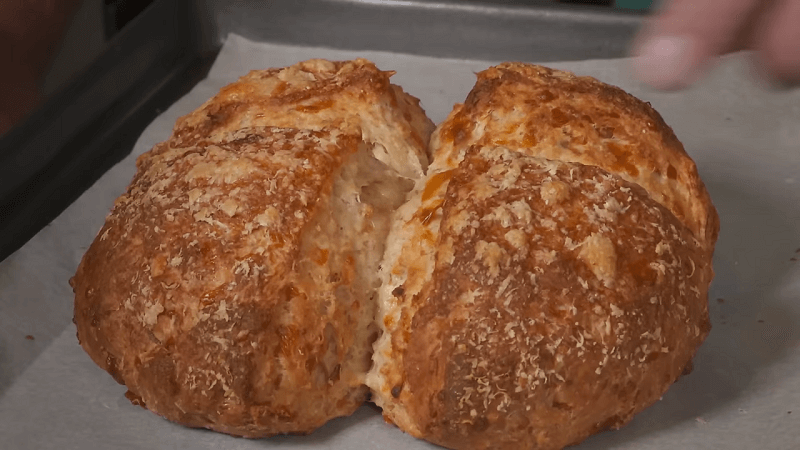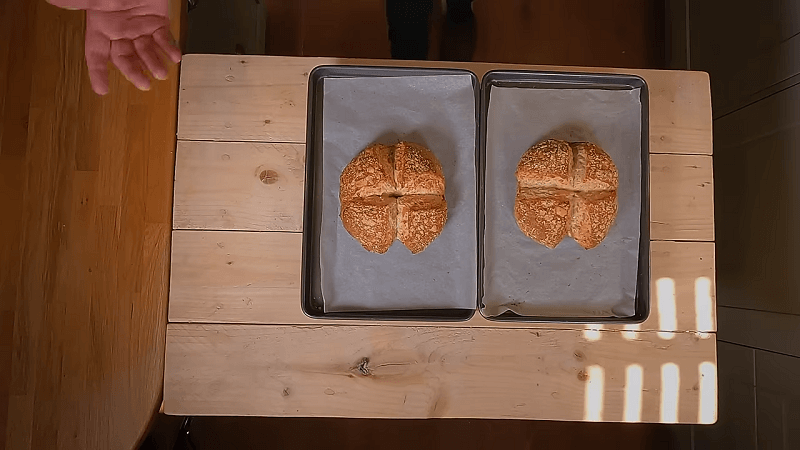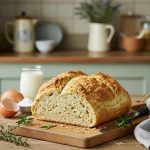Hey friends! I’m thrilled to share my love for Mary Berry’s Soda Bread recipe, a staple in my kitchen that’s as easy as it is delicious. This yeast-free bread comes together in under an hour, delivering a crusty loaf perfect for any meal. Whether you’re a baking newbie or a seasoned pro, this recipe’s simplicity and versatility make it a must-try. Let’s dive into why I adore it, how to make it, and some fun ways to customize it!
Key Points
- Quick and Simple: Mary Berry’s Soda Bread recipe uses basic ingredients and requires no yeast or long rising times.
- Versatile: Easily adaptable for gluten-free or vegan diets, with options for add-ins like herbs or raisins.
- Cultural Gem: Rooted in Irish tradition, it’s a symbol of resilience, especially tied to St. Patrick’s Day.
- Beginner-Friendly: Minimal kneading and straightforward steps make it accessible for all skill levels.
Mary Berry Soda Bread Recipe
Why It’s a Favorite
I first tried Mary Berry’s Soda Bread recipe when I needed a quick side for a cozy soup night. It was a revelation—no fuss, just a warm, crusty loaf in under an hour. Its flexibility lets me tweak it for different flavors or dietary needs, and it always impresses my friends.
What You’ll Need
You only need a handful of pantry staples: flour, baking soda, salt, buttermilk, and optional honey. I love mixing wholemeal and white flour for a hearty texture. If you’re out of buttermilk, a quick milk-and-lemon-juice substitute works like a charm.
How to Make It
Mix the dry ingredients, stir in the buttermilk, and form a soft dough. Shape it into a round, score a deep cross, and bake at 200°C for 30-35 minutes. Let it cool slightly, then enjoy the crisp crust and soft interior.
Serving Ideas
This bread shines with butter and jam, pairs perfectly with soups, or makes delicious sandwiches with smoked salmon. It’s best fresh but freezes well for later. Experiment with add-ins like oats or herbs to match your meal.
Mary Berry’s Soda Bread: My Go-To Recipe for Quick Bread
Hey friends! Gather around, because I’m about to share one of my favorite baking secrets: Mary Berry’s Soda Bread recipe. This bread is a lifesaver when you want homemade goodness without spending hours in the kitchen. No yeast, no long rising times—just mix, shape, and bake, and in under an hour, you’ve got a warm, crusty loaf that’s perfect for breakfast, lunch, or dinner. I first stumbled upon this Mary Berry Soda Bread recipe when I needed a quick side for a hearty tomato soup on a chilly evening. Let me tell you, it was love at first bite! The combination of wholemeal flour and oats gives it a rustic texture, and a touch of honey adds a subtle sweetness that balances the tangy buttermilk.
This recipe is a gem because it’s so versatile. Whether you’re baking for a cozy family dinner or a festive St. Patrick’s Day spread, it adapts to your needs. You can keep it traditional or jazz it up with add-ins like herbs or raisins. Plus, it’s beginner-friendly, so even if you’re new to baking, you’ll nail it. Let’s dive into the details—ingredients, method, history, variations, and more—to help you make this bread your own.
Why I Love This Recipe
I can’t get enough of Mary Berry’s Soda Bread recipe. It’s my go-to when I crave fresh bread but don’t have time for yeast-based recipes. The simplicity is unbeatable—just a few ingredients, no kneading, and no waiting for dough to rise. I’ve made it for friends at casual hangouts, and they’re always impressed by the crusty exterior and soft, flavorful interior.
What makes it special is its flexibility. You can tweak it for gluten-free or vegan diets or add ingredients like oats or rosemary to suit your taste. It’s also forgiving; even if you’re not precise with measurements, it still turns out great. I’ve baked it dozens of times, and it’s never let me down.
Ingredients: What You’ll Need
Here’s what you need to whip up this bread:
- 500g plain flour: I often mix 250g wholemeal and 250g white flour for a nutty, hearty flavor. All white flour works for a lighter loaf.
- 1 tsp baking soda: This is the key to the bread’s rise, so make sure it’s fresh.
- 1 tsp salt: It enhances the flavor—don’t skip it.
- 400ml buttermilk: It reacts with the baking soda for that perfect rise. No buttermilk? Mix 1 tbsp lemon juice or vinegar with 400ml milk and let it sit for 10 minutes.
- 1 tbsp honey (optional): I love the subtle sweetness it adds, especially with savory pairings.
The flour choice is up to you. Wholemeal flour, as used in some versions (The Happy Foodie), adds a rustic, nutty vibe, while strong white flour gives a lighter texture. For gluten-free diets, a gluten-free flour blend with xanthan gum works, though the loaf may be denser. Buttermilk is crucial for that authentic tangy flavor, but the milk-and-lemon trick is a reliable substitute. Honey, while optional, complements the bread’s tang and makes it versatile for sweet or savory dishes.

Method: Let’s Get Baking
Making this bread is a breeze. Here’s how I do it:
- Preheat the oven: Set it to 200°C (400°F) and line a baking tray with parchment paper. This prevents sticking and makes cleanup easy.
- Mix dry ingredients: In a large bowl, combine flour, baking soda, and salt. Stir well to distribute evenly.
- Add wet ingredients: Pour in the buttermilk and honey (if using). Mix with a wooden spoon or your hands until a soft, slightly sticky dough forms. Don’t overmix—it’s not a yeast bread!
- Shape the loaf: Turn the dough onto a lightly floured surface. Knead it just 3-4 times to bring it together. Shape into a round loaf, about 5cm thick.
- Score the top: Place the loaf on the tray. Cut a deep cross halfway through the dough with a sharp knife. This helps it rise evenly and adds that classic look.
- Bake: Bake for 30-35 minutes until golden and hollow-sounding when tapped on the bottom. If it browns too fast, cover with foil.
- Cool: Let it cool on a wire rack for 10-15 minutes. Slicing too soon can make it crumbly, so be patient!
A lesson from my early attempts: cut that cross deep! My first loaf was dense in the middle because I didn’t score it enough. For a crisper crust, brush the top with a little milk before baking, though I usually keep it simple.
The History and Cultural Significance of Irish Soda Bread
Irish soda bread has a rich history that goes back to the 1830s, when baking soda became widely available in Ireland (Trafalgar). It was a game-changer during the Great Famine of the 1840s, when yeast was scarce, and people needed an affordable way to make bread. With just flour, salt, baking soda, and buttermilk, it became a staple in Irish homes, baked in three-legged iron pots or on griddles over open hearths.
The bread’s shape carries cultural meaning. In Northern Ireland, it’s often divided into four triangles, called farls, while in Southern Ireland, it’s a round loaf with a cross cut into the top. This cross isn’t just practical—it helps the bread expand—but also ties to superstitions, like letting fairies out or warding off evil (BBC). Soda bread symbolizes resilience, especially during tough times like the famine, when it was sometimes the only food available.
Today, it’s a beloved part of Irish culture, especially during St. Patrick’s Day, when it’s served with corned beef and cabbage or slathered with butter. Each family has its own recipe, passed down through generations, making it a cherished tradition (ShanOre).
Variations: Make It Your Own
This recipe is a blank canvas for creativity. Here are some variations I’ve tried:
- Gluten-Free: Use a gluten-free flour blend with 1 tsp xanthan gum for structure. It’s denser but still delicious (Oh My Recipe).
- Vegan: Swap buttermilk for plant-based milk (soy or almond) mixed with 1 tbsp lemon juice. Use agave syrup instead of honey. The result is just as fluffy.
- Add-Ins: Fold in 50g oats for texture, as suggested by The Happy Foodie, or add raisins for a sweet “spotted dog” version. Chopped rosemary or cheddar makes it savory.
- Butter Version: Some recipes, like one from Mary Berry Recipes, add 55g cold butter, rubbed into the flour, for a richer crumb.
- Guinness and Treacle: For a deep, rich flavor, try adding a splash of Guinness and a tablespoon of treacle (Wikipedia).
- Regional Twists: In Ulster, try wheaten bread (sweetened wholemeal), or in Fermanagh, make fadge with white flour.
Each variation adds its own flair. Oats give a chewy texture, butter makes it tender, and Guinness adds a malty depth. Just don’t overwork the dough—keep it light for the best results.
Troubleshooting Common Issues
Baking soda bread is straightforward, but a few hiccups can happen. Here’s how I fix them:
- Dense Bread: Overmixing develops too much gluten, making the bread tough. Mix just until the dough comes together.
- Uneven Rising: Cut a deep cross to let the bread expand evenly. Check that your baking soda is fresh—old soda won’t rise properly.
- Dry Bread: Too little buttermilk can dry out the dough. Aim for a soft, slightly sticky consistency.
- Burned Bottom: If your oven runs hot, check the bread at 30 minutes and cover with foil if it’s browning too fast. Use parchment paper to prevent sticking.
One time, I used expired baking soda, and the loaf was flat as a pancake. Now, I always check the expiration date. These tips will help you nail a perfect loaf every time.
Storage and Serving Suggestions
Soda bread is best eaten fresh, when the crust is crisp and the inside soft. Wrap leftovers in a tea towel or paper bag at room temperature for 2-3 days—plastic makes it soggy. For longer storage, slice and freeze in a freezer bag for up to 3 months. Toast slices straight from frozen for that fresh-baked taste.
Serving ideas are endless! For breakfast, I slather thick slices with butter and jam. For lunch, it’s perfect with soups or Irish stew, soaking up every drop. For dinner, try it with smoked salmon and cream cheese or as part of a cheese board with sharp cheddar and chutney. I once served it at a party with a herby dip, and it was a hit. Traditional Irish pairings include corned beef and cabbage or a simple spread of butter (Price Chopper).
Nutritional Benefits
Soda bread is not just tasty—it’s got some nutritional perks. Using wholemeal flour adds fiber, which is great for digestion. Buttermilk provides calcium and protein, though it’s higher in sodium than regular milk. The basic recipe is low in fat, especially without added butter, making it a wholesome choice. If you add oats or nuts, you boost the fiber and healthy fats. However, it’s not ideal for low-carb diets, as flour is the main ingredient. For a healthier twist, try a wholemeal version with seeds for extra nutrients.
Comparison Table: Mary Berry’s Soda Bread Variations
Here’s a comparison of three takes on Mary Berry’s Soda Bread recipe to help you choose:
| Feature | Oh My Recipe | The Happy Foodie | Mary Berry Recipes |
| Flour | 500g plain (option for wholemeal) | 450g strong white | 450g all-purpose |
| Leavening | 1 tsp baking soda | 1 tsp bicarbonate of soda | 1 tsp baking soda |
| Salt | 1 tsp | 1 tsp | 1 tsp |
| Liquid | 400ml buttermilk | 300ml buttermilk or 150ml milk + 150ml yoghurt | 300ml buttermilk or soured milk |
| Fat | None | None | 55g cold butter |
| Sweetener | 1 tbsp honey (optional) | None | None |
| Bake Time | 30-35 min | 40-45 min | 35-40 min |
| Unique Feature | Optional oats for texture | Milk + yoghurt option | Butter for richness |
The Oh My Recipe version is my go-to for its flexibility and optional honey. The Happy Foodie’s milk-and-yoghurt option is handy if you’re out of buttermilk. The butter in Mary Berry Recipes’ version adds a tender, rich crumb.
Decision-Making: Which Version Should You Choose?
Choosing the right version depends on your needs. If you’re a beginner or want a versatile loaf, go with the Oh My Recipe version (Oh My Recipe). Its optional honey and oat add-ins make it adaptable, and it’s quick to whip up. If you prefer a lighter texture, try The Happy Foodie’s version with strong white flour (The Happy Foodie). For a richer, more indulgent bread, the Mary Berry Recipes version with butter is perfect (Mary Berry Recipes). All are delicious, so you can’t go wrong—just pick based on your taste and pantry.
Final Thoughts
Mary Berry’s Soda Bread is more than a recipe; it’s a slice of Irish heritage that brings comfort to any table. Its simplicity, versatility, and rich history make it a joy to bake and share. Whether you’re dunking it in soup, pairing it with cheese, or enjoying it with a smear of butter, this bread is sure to become a favorite. Give it a try, and let me know how it turns out at your next hangout!
Mary Berry Soda Bread Recipe
Ingredients
- 500g (4 cups) plain flour
- 1 tsp baking soda
- 1 tsp salt
- 400ml (1 ¾ cups) buttermilk
- 1 tbsp honey (optional, for a hint of sweetness)
Notes
Cooking Steps:
- Preheat Oven: Set oven to 200°C (400°F). Line a baking tray with parchment paper.
- Mix Dry Ingredients: In a large bowl, whisk together flour, baking soda, and salt.
- Add Wet Ingredients: Make a well in the center, pour in the buttermilk, and mix until it forms a soft dough.
- Shape the Dough: Lightly flour a surface, knead the dough briefly, and shape it into a round loaf.
- Score the Top: Use a sharp knife to cut a deep cross on top of the loaf.
- Bake: Place on a baking sheet and bake for 30-35 minutes until golden brown and sounds hollow when tapped.
- Cool & Serve: Let cool on a wire rack before slicing.
Calories:
Hello! I am a seasoned culinary veteran whose passion for cooking began in my family kitchen and later I explored global cuisines. Now as a owner of the "OhMyRecipe" blog, I share my expertise by blending classic techniques with innovative twists. I advocates for culinary education and community engagement, making cooking accessible and enjoyable for all. Join me on a flavor-filled journey of delicious dishes and culinary inspiration.
- Jessica Hhttps://ohmyrecipe.com/author/abrecipe/
- Jessica Hhttps://ohmyrecipe.com/author/abrecipe/
- Jessica Hhttps://ohmyrecipe.com/author/abrecipe/
- Jessica Hhttps://ohmyrecipe.com/author/abrecipe/



